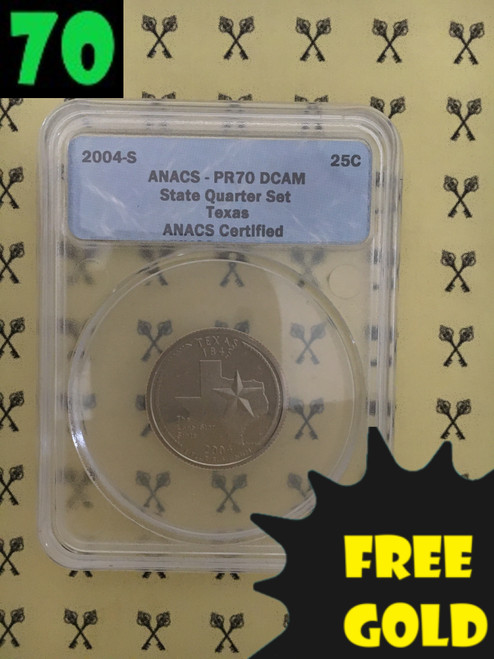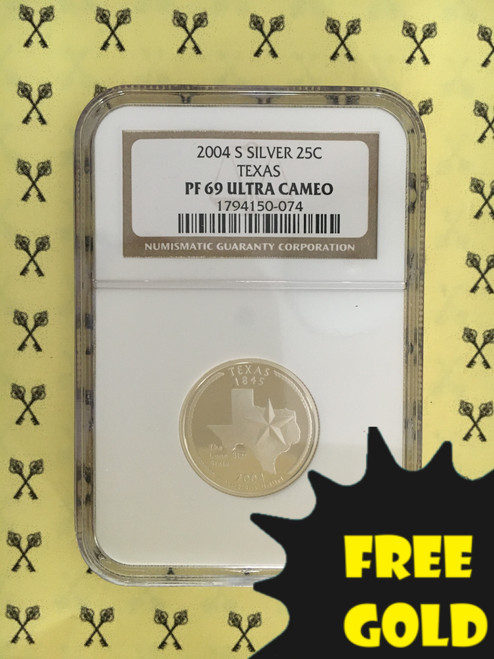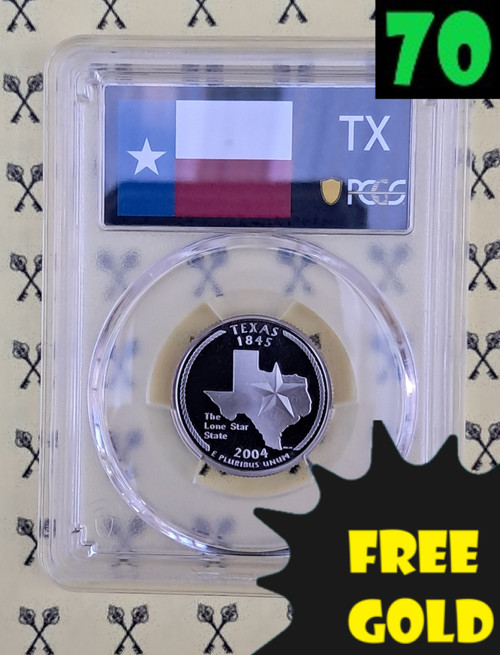-

-

-

2004-S Texas State Quarter PERFECT ANACS PR70 DCam with FREE 1/2 GOLDBACK*
MSRP: $40.00$27.57 -
RESTOCKING

-
RESTOCKING

-
RESTOCKING

-

-

Goldback
2025 Dallas/Fort Worth Texas 1 Goldback FIRST EVER CITY GOLDBACK 100 Pack
MSRP: $872.00$826.00
Texas
Will Texas be the next state to get a Half Goldback?

Texas Goldback 1/2 (Half) Concept. Click image to see all the 0.5 Goldbacks available for sale.
First city Goldback of Dallas/Fort Worth Texas is only $7.90
Why Texas Should Be the Next State to Get a Goldback Series
In October of 2025, the city of Dallas/Fort Worth Texas was the first metropolitan area to get its own Goldback. Though, only a One Goldback note was minted. The Dallas Goldback is just a start. It is expected that Texas will get its own complete series of Goldbacks in the near future.
The Lone Star State’s Golden Roots
Texas, the "Lone Star State," has a golden heritage etched into its vast landscape. While not as famed as California, placer gold was prospected along the Llano River in the 19th century, and legends of lost treasures—like the San Saba Mine—dot its history. Today, Texas stands as a beacon of economic independence with the Texas Bullion Depository, safeguarding gold since 2018. The Goldback—a voluntary, spendable gold currency—revives this legacy, offering Texans a tangible link to their pioneering spirit. Why not let Texas shine as the next golden star?
Legislative Goldmine: Texas’s Sound Money Advantage
Texas is a likely next Goldback candidate as Texas is the 6th best state in the 2024 & 2025 Sound Money Index and all 6 current Goldback states are in the top 12 Sound Money Index. Texas’s legislature has forged a golden path for sound money. In 2019, House Bill 2357 exempted precious metals stored in the Texas Bullion Depository from taxation, enhancing its appeal. In 2024, Senate Bill 1558 (SB 1558) aimed to establish gold and silver as legal tender but didn’t pass—yet its momentum persists. As of February 2025, House Bill 1049 (HB 1049) has passed the House State Affairs Committee on February 20, proposing state-issued gold-backed transactional currencies, awaiting full House vote. Texas ranks 6th in the 2024 Sound Money Index, making it Goldback-ready.
Economic Resilience and Lone Star Pride
The Goldback bolsters Texas’s economy and spirit. Starting at 1/1000th of an ounce, it’s ideal for small buys—from Austin’s taco trucks to San Antonio’s craft stalls. With inflation a concern, its gold backing offers stability, aligning with Texas’s independent ethos. Picture a Goldback series showcasing state icons: the Alamo, Fort Worth Cattle Drive or Big Bend. These notes would be collectibles, boosting tourism and pride. Businesses adopting Goldbacks could draw sound-money enthusiasts, enhancing local trade. This is Texas’s chance to lead with gold.
Texas-Specific Goldback Designs
Here’s how Texas’s Goldback denominations could honor its significant people and places:
- 1 Goldback (1/1000 oz): Features a prospector panning the Llano River, recalling Texas’s 19th-century gold heritage.
- 5 Goldback (1/200 oz): Depicts the Stockyards of Fort Worth with a cowgirl bringing in Longhorn Steers from the Chisholm Trail.
- 10 Goldback (1/100 oz): Showcases the Alamo under golden dawn, reflecting its enduring symbol of resilience.
- 25 Goldback (1/40 oz): Highlights Annette Strauss, the first female mayor of Dallas, with the Dallas arts & culture that she made famous.
- 50 Goldback (1/20 oz): Pictures Big Bend National Park’s golden cliffs, embodying Texas’s vast natural beauty.
These designs transform the Goldback into a vibrant tribute to Texas’s history and spirit, blending value with Lone Star pride.
A Golden Call to Lead the South
Utah, Nevada, and others have Goldbacks, but Texas can lead the South. With HB 1049 advancing, a top Sound Money Index ranking, and a gold legacy tied to the Texas Bullion Depository, Texas is primed to pioneer this currency in the region. Let’s urge the House to pass HB 1049 and launch a Texas Goldback series. Imagine gold in every hand—from Houston to El Paso—proving the Lone Star State isn’t just big in size but bold in prosperity. The time is now.
Rise up. Make Texas golden.
Will Texas create their own gold & silver currency?
Texas is taking bold steps toward financial independence by passing House Bill 1056 (HB 1056) in the 89th Legislature (2025-2026) on May 1st, 2025. This legislation proposes the creation of a state-issued digital currency fully backed by gold and silver, a move that could redefine the state’s economic landscape. By leveraging the Texas Bullion Depository and drawing on constitutional principles, Texas aims to establish a sound money alternative to Federal Reserve notes. A late amendment to the bill, requires approval from a “federal court of competent jurisdiction” before Texas can issue its own currency. The next steps are to approve the bill in the state senate and prove that the currency meets federal regulations. Below, we explore the motivations behind HB 1056 and why Texas may create its own gold and silver currency.
Economic Stability Through Sound Money
One of the primary drivers behind HB 1056 is the desire to protect Texans from inflation and economic instability. Federal Reserve policies, including quantitative easing and low interest rates, have raised concerns about the devaluation of the U.S. dollar. Gold and silver, historically stable stores of value, offer a hedge against such risks. HB 1056 mandates that the Texas Comptroller issue gold and silver specie (coins) and establish a digital currency 100% backed by these precious metals. This currency would be redeemable in physical metals or cash, providing Texans with a reliable medium of exchange immune to inflationary pressures.
Countering Central Bank Digital Currencies (CBDCs)
The rise of central bank digital currencies (CBDCs) globally has sparked fears of increased government surveillance and control over financial transactions. HB 1056 positions Texas as a counterweight to CBDCs by offering a decentralized, precious metal-backed alternative. The bill’s supporters argue that a state-issued gold and silver currency would preserve financial privacy and autonomy, allowing Texans to transact without reliance on federally controlled digital systems. By establishing this currency as legal tender for debt payment in Texas, HB 1056 aims to create a viable competitor to potential federal digital currencies.
Leveraging the Texas Bullion Depository
Central to HB 1056 is the Texas Bullion Depository, operational since 2020 in Leander, Texas. The depository serves as the secure storage facility for the gold and silver backing the proposed currency. Under HB 1056, the depository would issue specie and manage a pooled account of precious metals, with the digital currency representing fractional ownership of these assets. This infrastructure, unique among U.S. states, gives Texas the capacity to implement a gold-backed currency without relying on external institutions, reinforcing state sovereignty over its financial systems.
Constitutional and Historical Precedent
HB 1056 draws inspiration from Article I, Section 10 of the U.S. Constitution, which prohibits states from making anything but gold and silver coin a tender for debts. Proponents of the bill view it as a return to constitutional money, bypassing the Federal Reserve’s fiat currency system. Texas has a history of embracing precious metals, having established the nation’s first state-administered bullion depository in 2015. HB 1056 builds on this legacy, positioning Texas as a leader in the modern sound money movement and potentially inspiring other states to follow suit.
Broad Political Support
The bipartisan support for HB 1056 underscores its appeal across political divides. With 63 Republicans and 20 Democrats as co-sponsors, the bill reflects a shared concern about economic uncertainty and federal overreach. This broad backing increases the likelihood of HB 1056 advancing through the legislative process, despite challenges such as a recent amendment-related delay on the House floor in May 2025. The bill’s popularity signals Texas’ readiness to embrace innovative financial solutions that prioritize stability and independence.
Practical Benefits for Texans
HB 1056 is designed to integrate seamlessly into daily life. The proposed digital currency would be electronically transferable, similar to modern payment systems, and usable via debit card-like mechanisms for everyday transactions. This practicality makes the currency accessible to businesses and individuals alike. Additionally, the currency’s redeemability in gold or silver specie ensures tangible value, offering Texans a choice between fiat dollars and precious metal-backed money. Such flexibility could enhance consumer confidence and stimulate local economies.
Challenges and Criticisms
Despite its ambitions, HB 1056 faces hurdles. Critics argue that a gold-backed digital currency could be volatile, given fluctuations in precious metal prices. Regulatory challenges, including compliance with federal banking laws, may complicate implementation. Additionally, the Texas Bullion Depository’s capacity to manage large-scale gold and silver reserves remains untested at the scale envisioned by HB 1056. However, supporters counter that these challenges are surmountable, citing Texas’ robust infrastructure and the bill’s careful design to ensure stability and compliance.
A Vision for the Future
HB 1056 represents more than a financial experiment; it’s a statement of Texas’ commitment to economic sovereignty and resilience. By creating a gold and silver-backed currency, Texas seeks to shield its citizens from inflation, reduce dependence on federal monetary systems, and offer a model for sound money nationwide. As the 89th Legislature debates this groundbreaking bill, the eyes of the nation are on Texas, watching to see if it can turn this vision into reality. Whether HB 1056 passes or sparks further innovation, it underscores Texas’ role as a trailblazer in redefining money for the 21st century.
Texas State Coins for Sale with free gold
Celebrate Texas' statehood with a Perfect Proof 70 Deep Cameo quarter.